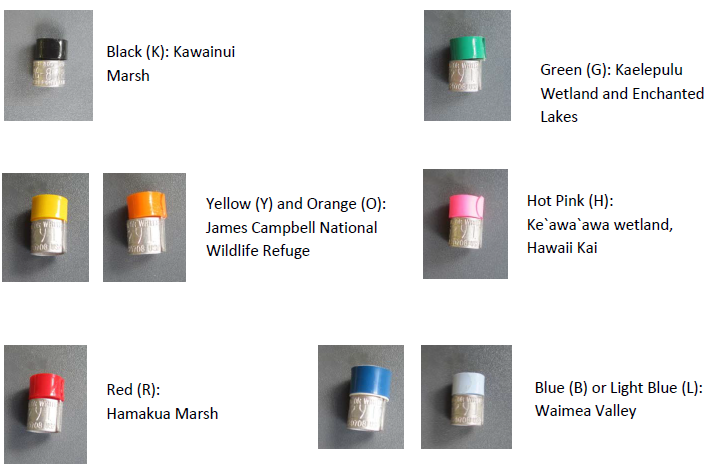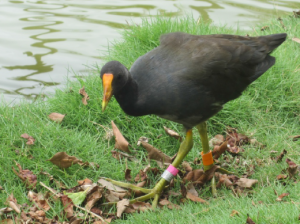Aloha!
Mahalo for your interest in the `alae `ula movement study! This guide describes the purpose of our study, and how you can help contribute to research protecting the `alae `ula. If you have any questions or concerns please contact Charles van Rees at Charles.van_rees@tufts.edu or Michael Reed at
Michael.Reed@tufts.edu
The `Alae `ula needs your kokua!
The `alae `ula (also known as the Hawaiian Moorhen or Hawaiian Gallinule, Gallinula galeata sandvicensis) is an endangered native waterbird endemic to the Hawaiian islands. According to Polynesian legend, the demigod Maui stole fire from the `alae and used one as bait when he fished the Hawaiian Islands out of the ocean. These charismatic birds were once found on all of the main Hawaiian islands, but are now only found on O`ahu and Kaua`i. `Alae `ula numbers have decreased dramatically due to wetland loss for coastal development and the introduction of exotic predators like cats, mongoose, bullfrogs, and turtles that eat their eggs and young. Scientific research on the `alae `ula is a key step to developing management to protect their threatened populations and a unique part of Hawaii’s ecological and cultural heritage.
Our study:
This study, a collaboration between Tufts University (near Boston, MA), U.S. Fish and Wildlife service and U.S. Geological Survey, is designed to understand the movement behavior of `alae `ula on O`ahu. Our goal is to find out how often they move between their fragmented wetland habitats and what routes they take to do so. This information will allow researchers to understand how future development and changes in the landscape will affect `alae `ula populations, and how current wetlands can be managed to best support the species.
How you can help:
Every time a banded Alae `ula is spotted somewhere, that sighting is a “fix” on that bird’s location. Gathering fixes over time helps scientists get an idea of where that bird spends it’s time and how it
moves around the landscape. When it comes to understanding bird movement, the more fixes the better. The easiest and biggest way to give your kokua to studying the Alae `ula is to act as an extra set of eyes for our ongoing movement study, and try to spot banded moorhen in wetlands in your area, and report your sightings to the project.
Where to look?
`Alae `ula tend to nest and hide near the water in tall vegetation. They are normally feed in open areas near marshes, streams, drainage canals, or ponds. `Alae `ula are primarily vegetarian, and feed on plants on open lawns and floating vegetation, especially `ae`ae, or water hyssop in marshes, and lawns in parks or urban areas.
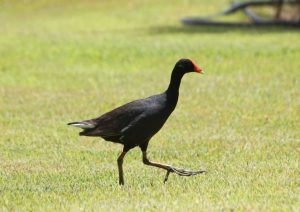 Good places to spot `Alae `ula are Hamakua and Kawainui marshes and Enchanted Lakes in Kailua, the James Campbell National Wildlife in Kahuku, the Hono`uli`uli wetland of the Pearl Harbor National Wildlife Refuge in Pearl City, the estuaries and ponds in Waimea Valley, and the Ke`awa`awa wetland in Hawaii Kai. `Alae `ula can also be found on many of Oahu’s golf courses, including Turtle Bay’s Palmer golf course and Olomana golf links, so keep an eye out for them if you’re out for a few rounds!
Good places to spot `Alae `ula are Hamakua and Kawainui marshes and Enchanted Lakes in Kailua, the James Campbell National Wildlife in Kahuku, the Hono`uli`uli wetland of the Pearl Harbor National Wildlife Refuge in Pearl City, the estuaries and ponds in Waimea Valley, and the Ke`awa`awa wetland in Hawaii Kai. `Alae `ula can also be found on many of Oahu’s golf courses, including Turtle Bay’s Palmer golf course and Olomana golf links, so keep an eye out for them if you’re out for a few rounds!
How to spot `Alae `ula:
 Just like in Hawaiian legends, the `alae are shy and secretive birds that can be difficult to spot. When they spot people, they will often run and hide in tall vegetation until they feel it is safe to come out again. Once you arrive in a place you think is occupied by `alae `ula, it is best to sit quietly for 15‐25 minutes and wait to see if they appear. You may also hear them calling to check up on one another as they begin to get more comfortable. It is often easiest to stay inside
Just like in Hawaiian legends, the `alae are shy and secretive birds that can be difficult to spot. When they spot people, they will often run and hide in tall vegetation until they feel it is safe to come out again. Once you arrive in a place you think is occupied by `alae `ula, it is best to sit quietly for 15‐25 minutes and wait to see if they appear. You may also hear them calling to check up on one another as they begin to get more comfortable. It is often easiest to stay inside 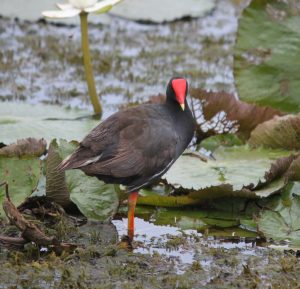 a vehicle like a golf cart or car when you visit a wetland, because the `alae see this as less of a threat than an actual person standing around.
a vehicle like a golf cart or car when you visit a wetland, because the `alae see this as less of a threat than an actual person standing around.
A pair of binoculars or a spotting scope are excellent tools for spotting `alae, but are not always necessary in places where birds are accustomed to people. In some areas, where `alae `ula are closer to their natural behavior, this may be the only way to get a good look at them. Where they are used to people (like Hamakua marsh), they may run right up to you expecting food! It’s fine to use this to your advantage, but please do NOT feed the `Alae`ula!
What to look for:
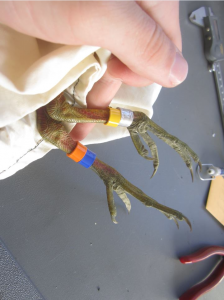 We tag our `Alae `ula with four leg bands, two on each leg. Three of these are plastic color bands thaT make a unique color code for each individual. The fourth band is made of aluminum, and is a U.S. Geological Survey band with a unique identification number on it. While you won’t be able to read that number from far away, finding the aluminum band will help orient you to the bird’s color combination. Whichever leg has the aluminum band will also have a single plastic band with it. This leg is the bird’s “passport”, which describes the wetland at which the bird was banded; each wetland has a color that matches it. The bird’s other leg has two color bands, which are specific to that bird at that particular wetland; so they act like a drivers
We tag our `Alae `ula with four leg bands, two on each leg. Three of these are plastic color bands thaT make a unique color code for each individual. The fourth band is made of aluminum, and is a U.S. Geological Survey band with a unique identification number on it. While you won’t be able to read that number from far away, finding the aluminum band will help orient you to the bird’s color combination. Whichever leg has the aluminum band will also have a single plastic band with it. This leg is the bird’s “passport”, which describes the wetland at which the bird was banded; each wetland has a color that matches it. The bird’s other leg has two color bands, which are specific to that bird at that particular wetland; so they act like a drivers 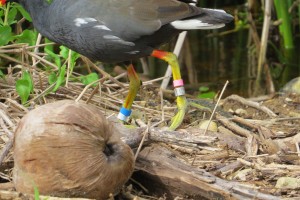 license. No other individual from that wetland will have that exact order of colors in combination.
license. No other individual from that wetland will have that exact order of colors in combination.
So, an individual with a red band over an aluminum band on its right leg, and a black band over a green band on its left leg, would be different than one with a green band over a black band on its left leg.
A list of all current band colors and their 1-letter abbreviations can be found below:
| A | Aluminum | K | Black |
| B | Blue | G | Green |
| L | Light Blue | S | Light Green |
| R | Red | P | Purple |
| O | Orange | I | Pink |
| Y | Yellow | H | Hot Pink |
| W | White | N | Brown |
It is easiest to see an `alae’s color bands when it is foraging or walking around in the open. It can become more challenging if the bird is swimming, or walking in thick vegetation. When this happens, it is best to watch the bird carefully and wait till it lifts its foot to take a step. `Alae `ula typically lift their feet up high between each step, and this is a great chance to catch a glimpse of their bands. Often you may have to put together the band combination one at a time! Unless the birds are very close, binoculars, or even a telescope, are a must‐have!
Most of the birds you see at a particular wetland should have the same “passport”; keep an eye out for that, and if you see “outsiders”, be sure to report them; this is a sure sign of movement!
Below are images of the “Passport” band combinations for each wetland on O`ahu – each of these is a plastic colored leg band above the aluminum band – the reverse pattern can also occur:
What to Report:
To make them easier to describe, `alae band combinations can be abbreviated into a code. The code is a series of four one‐letter abbreviations, one for each band, in order of how they appear on the bird. The bands are read in the following order, from the bird’s perspective (that is, if the bird is facing away from you ): Left leg upper, left leg lower, right leg upper, right leg lower. A colon “:” is placed between the two legs to distinguish them.
So, the bird described in the previous section, which had a red band over the aluminum one on the left leg, and black over green on the right leg would be RA:KG.
When reporting a sighting, three key bits of information are important: bird ID, date, and place. The bird ID should be reported in terms of band combination, or as many bands as were seen as possible; for example if you only saw the left leg of a bird that red RA:, you could report that by leaving the bands from the right leg blank, or putting in XX. Researchers could use other sightings to help figure out what bird it was you might have seen.
When reporting location and time, the more specific the better. At the very least, you should report the date of the sighting and the wetland at which the bird was sighted. If possible, information on specifically where in the wetland the bird was seen is even more useful; this can be provided as coordinates from a GPS unit (like a smartphone) or by clicking a location on the map of our report a sighting page.
If coordinates are not available, a written description can be provided, or you can look up the coordinates of your sighting location using Google maps.
Additional useful information can be things like what the bird was doing, and whether it was seen in association with any other birds, banded or otherwise.
A typical sighting might be as follows:
If I saw this:
Saw HA:OO at Ke`awa`awa wetland (21.289972, ‐157.707032) on July 27th, 2014 at 2pm.
If you are emailing the sighting, rather than using the web site, to avoid any potential confusion (as happens all the time!), it would be best to report the legs with the colors: left leg H over A, or hot pink over aluminum, and right leg O over O, or orange over orange.
Where to report a sighting:
You can email us with sighting information, or you can report it on our website.
On behalf of ourselves and the `Alae `ula, mahalo for your time and support!



